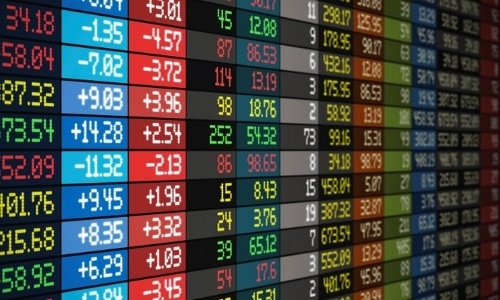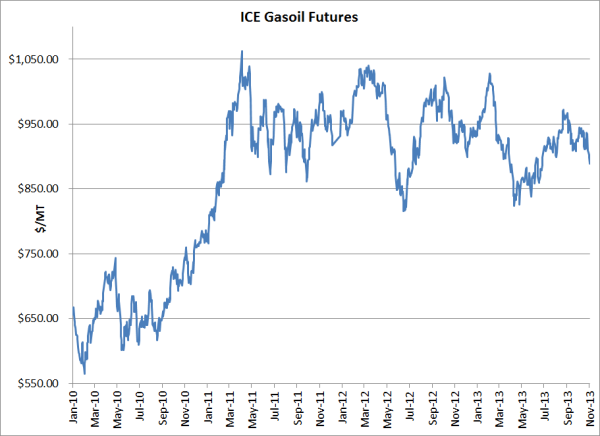2 min read
NYMEX Hedging Updates & New Micro Futures
As we noted in our May energy hedging Q&A, the NYMEX (CME) has been working on the transition process whereby the benchmark distillate (disel fuel,...
4 min read
Mercatus Energy : Jul 27,2015

On Friday NASDAQ Futures (NFX) launched twenty-six “new” commodity contracts in an attempt to take market share from incumbents CME (NYMEX) and ICE. While we have yet to review any official data from NFX's Friday trading session, it appears that they are currently seeing some modest activity in their Brent and WTI futures, albeit with wider bid-ask spreads and smaller size than on the incumbent CME and ICE screens. As an example, as of this moment the bid-ask spreads for both September 2015 Brent and WTI futures on NFX are about $0.20 wide while the bid-ask spreads for Brent (on ICE) and WTI (on CME) are only a penny or two. Likewise, in the past few minutes the size on both the bid and ask for both Brent (ICE) and WTI (CME) are averaging close to 10 lots, the size on NFX appears to somewhat static with 1 lot on each side.
In addition to Brent and WTI futures, NFX has launched twenty-four additional products including numerous Henry Hub natural gas contracts as well as contracts covering the most active US power markets (you can view the full list via this link). So what differentiates NFX's offerings from the incumbents? In short, lower fees. According to the highlights on their website, NFX's differentiators are competitive fee structure with no exchange execution or OCC clearing fees for the first nine months, cost-effective horizontal clearing model operated by the Options Clearing Corporation (OCC) and open and neutral access via standardized APIs and leading front-end providers. While we and most market participants wish NFX well, there is really only one major factor, liquidity, which ensures that a new exchange or product is sustainable. If NFX can attract liquidity they will likely achieve their goals of capturing 10% market share. If they can't, they will likely fall by the wayside as many others have over the years.
The launch of NFX's energy contracts begs a related question - will CME, ICE, any other exchange or platform launch products to cater to the ever changing dynamics of the global, physical energy markets? For example, the physical LNG market is set to become an enormous, global market in the coming years and as the market matures, market participants in many regions will need a contract(s) which will allow them to hedge their exposures in the physical markets. While Henry Hub can certainly be the LNG benchmark in the Americas and NBP in Europe, what about Asia-Pacific, Middle East and Africa? Given the ever increasing demand by LNG consumers and traders for gas, rather than crude oil, based pricing, one could certainly argue that the global LNG market will need to adopt an LNG price benchmark(s). And while the LNG market is currently dominated by a small number of players, this too will change as LNG begins to be marketed, sold and traded in smaller quantities i.e. marine fuel.
The Singapore Exchange (SGX) and its subsidiary, Energy Market Company (EMC), which runs the Singapore power market, is planning to launch an LNG index dubbed SLInG (Singapore SGX LNG Index Group). While it appears to be a serious, strong effort to develop an Asia-Pacific LNG benchmark, several LNG market participants have told us that they are unlikely to trade products which settle on SLInG as the current SLInG methodology isn't consistent with trading or settlement practices in the global oil and gas markets. As such, if SGX/EMC hopes to develop physical markets or futures, swaps or options contracts which settle based on SLInG, the index will have to meet the needs of market participants, both domestic and global. In addition, for such an index to attract trading liquidity the index must be transparent and as of today it appears that SGX/EMC is going to keep the index opaque for the time being. Per the EMC website, "The FOB Singapore SLInG is initially a private index, shared among the contributing stakeholders. After a trial and calibration period, the index can be used to develop products such as financial swaps for hedging purposes, and eventually in developing a physical delivery mechanism in Asia."
A few thousand miles north of Singapore, the Shanghai Futures Exchange's free trade zone subsidiary, Shanghai International Energy Exchange, has received approval from the China Securities Regulatory Commission to launch a crude oil futures contract. According to Platts, the contract will, "Trade in Chinese yuan, be physically settled, and will allow for delivery of Dubai, Oman, Qatar Marine, Basrah Light, Upper Zakum, Masila and Shengli crude oils, with an average gravity of 32 API and 1.5% sulfur. The SIFE will fix the price differentials for the various grades against the settlement prices for physical delivery." Again, while this appears to be a well-intended contract, as of today crude oil and refined products around the world trade in USD. Are oil producers and non-Chinese trading companies interested, willing and able to trade a contract which trades in CNY? Perhaps but as of today it doesn't seem extremely probable. TOCOM has listed crude oil, kerosene and gas oil contracts for many years but none of the three have ever attracted significant liquidty, as the contracts trade in JPY and are based on non-standard volumes rather than the global standard of 1,000 BBLs, among other reasons.
In addition to the NFX, SGX/EMC and SIFE products, there are numerous other parties which have developed or are looking to develop new energy products, some of which are indeed succeeding and attracting liquidity. For example, last week the EEX (European Energy Exchange) saw its recently launched Nordic power futures trade for the first time. In March CME, LOOP and NEO Markets launched an innovative physically delivered crude oil storage futures contract based on crude oil storage capacity at LOOP's Hub in Louisiana. While clearly still a young contract, as of Friday the LOOP futures contract had 5,255 lots in open interest.
In summary, the ever changing global energy market and its participants are always interested in new, unique indices, contracts and products which allow them to better manage their business, whether it be physical, financial or both. However for said indices, contracts and products to succeed, they must meet the needs of market participants in a way that builds liquidity as a market without liquidity isn't much of a market. Based on recent conversations we have had with several market participants, we expect that we’ll hear announcements of several new indices and contracts in the coming months.

2 min read
As we noted in our May energy hedging Q&A, the NYMEX (CME) has been working on the transition process whereby the benchmark distillate (disel fuel,...
2 min read
As the energy markets continue to evolve, NYMEX and ICE continue to introduce new contracts to accommodate the changing marketplace. As such, we...

3 min read
As many companies are beginning to plan for 2014, we have received quite a few inquiries from companies who are looking into hedging their gasoil...